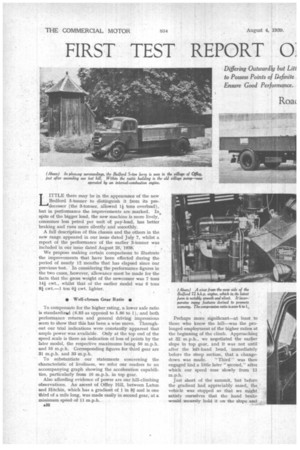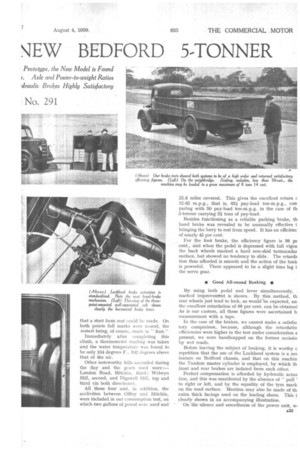FIRST TEST REPORT 0
Page 34

Page 35

Page 36

Page 37

If you've noticed an error in this article please click here to report it so we can fix it.
JEW BEDFORD 5-TONNER
Differing Outwardly but Litt to Possess Points of Definite Ensure Good Performance. • Prototype, the New Model is Found f. Axle and Power-to-weight Ratios 'draulic Brakes Highly Satisfactory
LITTLE there may be in the appearance of the now Bedford 5-tonner to distinguish it from its predecessor (the 3-tonner, allowed 11 tons overload), but in performance the improvements are marked. In spite of the bigger load, the new machine is more lively, consumes less petrol per unit of pay-load, has better braking and runs more silently and smoothly.
A full description of this chassis and the others in the new range appeared in our issue dated July 7, whilst a report of the performance of the earlier 3-tonner was included in our issue dated August 26, 1938.
We propose making certain comparisons to illustrate the improvements that have been effected during the period of nearly 12 months that has elapsed since our previous test. In considering the performance figures in the two cases, however, allowance must be made for the facts that the gross weight of the newcomer was 7 tons 14i cwt., whilst that of the earlier model was 6 tons 81, cwt.-1 ton 61 cwt. lighter.
• Well-chosen Gear Ratio • To compensate for the higher rating, a lower axle ratio is standardized (6.83 as opposed to 5.86 to 1), and both performance returns and general driving impressions seem to show that this has been a wise move. Throughout our trial indications were constantly apparent that ample power was available. Only at the top end of the speed scale is there an indication of loss of points by the later model, the respective maximums being 50 m.p.h. and 55 m.p.h. Corresponding figures for third gear are 31 m.p.h. and 33 m.p.h.
To substantiate our statements concerning the characteristic of liveliness, we refer our readers to an accompanying graph showing the acceleration capabilities, particularly from 10 m.p.h. in top gear.
Also affording evidence of power are our hill-climbing observations. An ascent of Offley Hill, between Luton and Hitchin, which has a gradient of 1 in 13f and is one third of a mile long, was made easily in second gear, at a minimum speed of ll £32 Perhaps more significant—at least to those who know the hill—was the pro longed employment of the higher ratios at the beginning of the climb. Approaching at 32 m.p.h., we negotiated the earlier slope in top gear, and it was not until after the left-hand bend, immediately before the steep section, that a change down was made. " Third " was then engaged and a little later " second," after which our speed rose slowly from 11 m. p. h.
Just short of the summit, but before the gradient had appreciably eased, the vehicle was stopped so that we might satisfy ourselves that the hand brake would securely hold it on the slope and that a start from rest could he made. On both points full marks were scored, the restart being, of course, made in " first," Immediately after completing this climb, a thermometer reading was taken and the water temperature was found to be only 164 degrees F„ 102 degrees above that of he air.
Other noteworthy hills ascended during the day and the gears used were :London Road, Hitchin, third ; Welwyn Hill, second, and Digswell Hill, top and third (in both directions).
All these four and, in addition, the acclivities between Offiey and Hitchin, were included in our consumption test, on which two gallons af petrol were used and 25.3 miles covered. This gives the excellent return c 12.65 m.p.g., that is, 631 pay-load ton-m.p.g., coif paring with 50 pay-load ton-m.p.g. in the case of th 3-tonner carrying 31 tons of pay-load.
Besides functioning as a reliable parking brake, th hand brake was revealed to be unusually effective i bringing the lorry to rest from speed. It has an efficienc of nearly 45 per cent.
For the foot brake, the efficiency figure is 50 pc cent., and when the pedal is depressed with full vigou the back wheels marked a hard non-skid tarmacadar surface, but showed no tendency to slide. The retarda tion thus afforded is smooth and the action of the brak is powerful. There appeared to be a slight time lag i the servo gear.
• Good All-round Braking • By using both pedal and lever simultaneously, marked improvemtnt is shown. By this method, th rear wheels just tend to lock, as would.be expected, an the excellent retardation of 60 per cent. can be obtained As is our custom, all these figures were ascertained b measurement with a tape.
In the case of the brakes, we cannot make a satisfac tory comparison, because, although the retardatio efficiencies were higher in the test under consideration a present, we were handicapped on the former occasio by wet roads.
Before leaving the subject of braking, it is worthy c repetition that the use of the Lockheed system is a neN feature on Bedford chassis, and that on this machin the Tandem master cylinder is employed, by which th front and rear brakes are isolated from each other.
Perfect compensation is afforded by hydraulic actua tion, and this was manifested by the absence of" pull' to right or left, and by the equality of the tyre mark on the mad surface. Mention may also be made of th extra thick facings used on the leading shoes. This i clearly shown in an accompanying illustration.
On the silence and smoothness of the power unit, w e33 can first assert that the proneness towards detonation that used to characterize Bedford engines has been entirely removed. Next, we admit that, on one occasion, we operated the starter when the engine was already ticking over, because its running was virtually undetectable. Thirdly, it is no exaggeration to say that vibration is as nearly non-existent as in a high-grade private car.
To the driver's comfort a big contribution is, in this way, made. The makers' efforts on his behalf do not stop here, however. Good outlook, adequate ventilation and scientific seat design are further factors to the same end. In this connection we were pleased to note that, no doubt as a result of a criticism we made last August, a heat-resistant mat has been provided. Furthermore, the cab roof is lined, with the object of diminishing drumming and maintaining a temperate atmosphere in the driver's compartment.
Good springing is also a feature that came to our notice, and it happens that a point of refinement, in this respect, has become the cause for a minor criticism—one, however, that should be easily rectifiable. With the load carried during our test, the builtin helper springs were only just in contact with the frame, and, consequently, clanked against the abutments under bumpy conditions. We suggest rubber pads, bonded on to the brackets.
When handling this new Bedford, we found its controllability an outstanding feature. It can be pulled around corners, at low speeds, easily, whilst gear changing, both up and down, gave us not the slightest difficulty.
The clutch is light and takes up the drive smoothly without the need for skilful manipulation. No longer rathek too sensitive, the foot-brake control received our approval, and we definitely liked the new position of the hand-brake lever.
Even when carefully planned to constitute a reasonably exacting and comprehensive if rough-and-ready test, a (30-odd-mile run can hardly be regarded as exhaustive. Nevertheless, we have, in the past, based upon it opinions, both good and bad, of numerous commercial motors, and we have rarely bee wrong in our judgment. In this case, to reiterate ot opening paragraph, our view, in short, is that this late: Bedford represents a big advance on its prototype.
In conclusion, we should, perhaps, remind our readei that the 5-tonner, forming the subject of this road tea is an addition to the Bedford range and that th 3-tonner, referred to, has now been replaced by a ne, model described as a 3-4-tonner.




































































